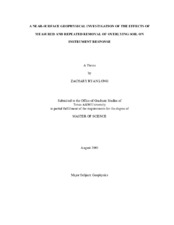| dc.description.abstract | A geophysical survey presents many challenges. A scientist must be able to not
only understand the theory and nature of the geophysics being applied but must also be
able to identify features of interest in a dataset. It is also of extreme importance to be
able to determine where, in the subsurface, the features identified in the data occur.
This research is designed in an attempt to identify the locations of subsurface
heterogeneities that affect geophysical instrument response. An experiment was
conducted in which topography, magnetics, ground-penetrating radar (GPR), and
electromagnetic induction (EM) data were collected over a defined survey line. An
excavator with a modified flat-bladed bucket was used to remove, or skim, a 5 to 10 cm
thick layer of material from the survey line. Upon removal of the material, datasets from
the above mentioned instruments were again collected along the same survey line. This
process was repeated for 10 skims, resulting in a total of 11 sets of data for each
instrument.
Having collected data with various instruments in the same location as material
was progressively removed allowed for an empirical study with the goal of noting how the response of each instrument changed with respect to the removal of material. By
observing how the anomalies changed in the data from one skim to the next, a better
understanding of the location of the causative heterogeneities could be had.
Data for each instrument was compared to the equivalent data collected from
each subsequent skim to determine how similar or different the data appeared as the
depth of the trench increased. The experiment also sought to determine if the
topographic variations, or roughness, along the survey line had any impact of the
geophysical signals. The data collected from each instrument were compared to the
topographic roughness of the survey line for the corresponding skim. | en |


